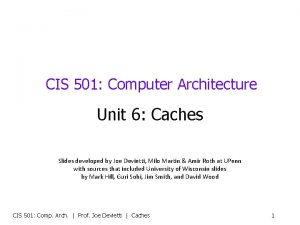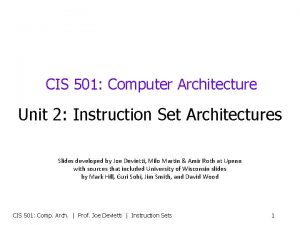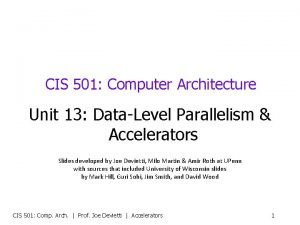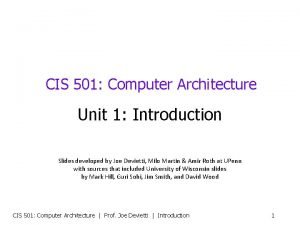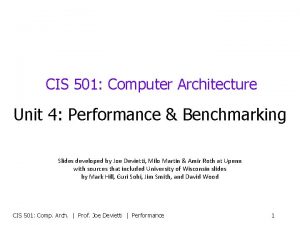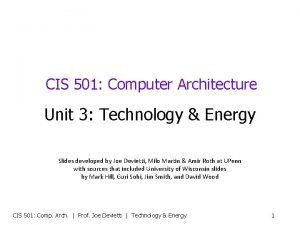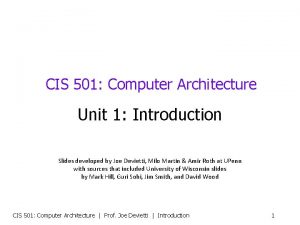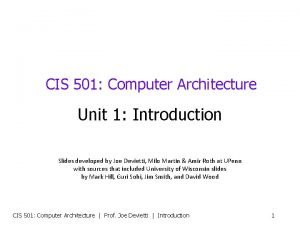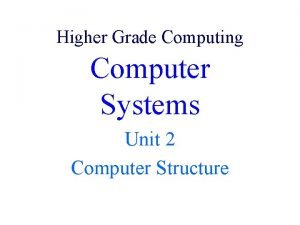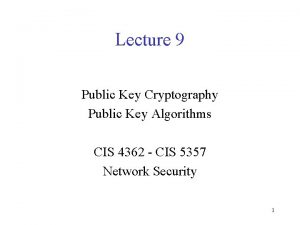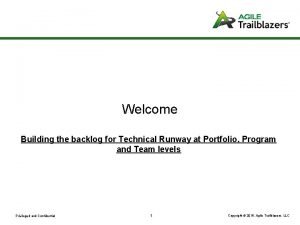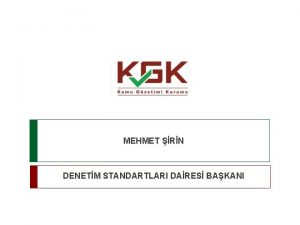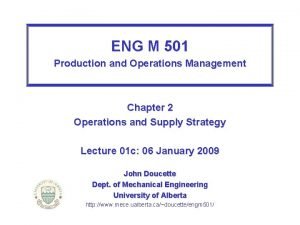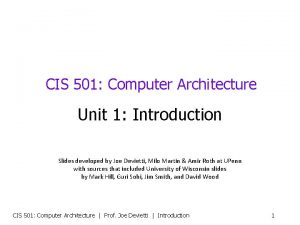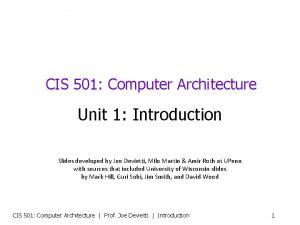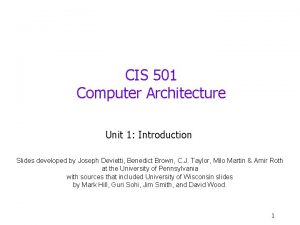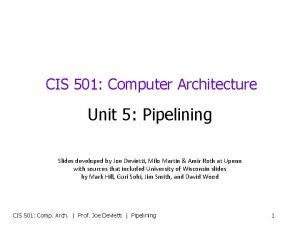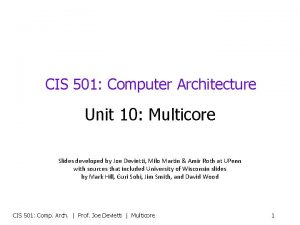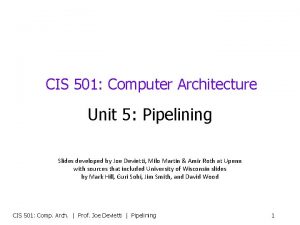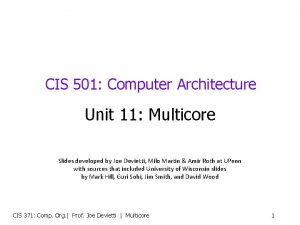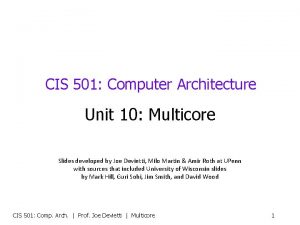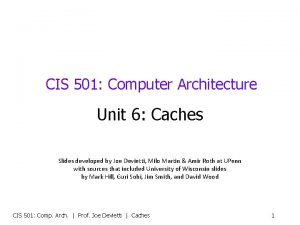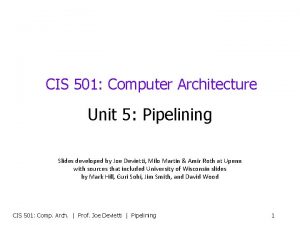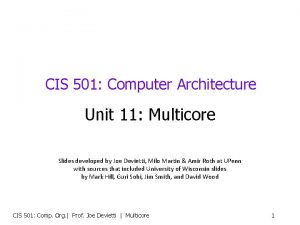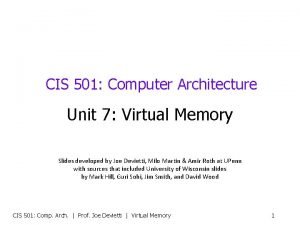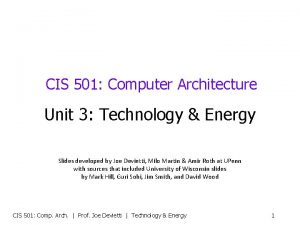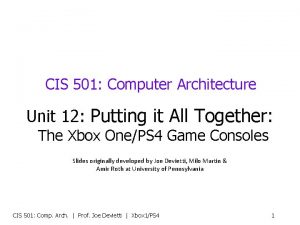CIS 501 Computer Architecture Unit 1 Introduction Slides






















- Slides: 22

CIS 501: Computer Architecture Unit 1: Introduction Slides developed by Joe Devietti, Milo Martin & Amir Roth at UPenn with sources that included University of Wisconsin slides by Mark Hill, Guri Sohi, Jim Smith, and David Wood CIS 501: Computer Architecture | Prof. Joe Devietti | Introduction 1

Administrative Things • • • poll for Joe’s office hours on Piazza lectures are being recorded slides will be posted before class first paper review due Wed, 4 Sep at midnight via Canvas short pitch for EAS 590: Commercializing Software CIS 501: Computer Architecture | Prof. Joe Devietti | Introduction 2

Technology Trends CI 12 501: Computer Architecture | Prof. Joe Devietti | Introduction 3

Constant Change: Technology “Technology” Logic Gates SRAM DRAM Circuit Techniques Packaging Magnetic Storage Flash Memory Goals Function Performance Reliability Cost/Manufacturability Energy Efficiency Time to Market Applications/Domains Desktop Servers Mobile Phones Supercomputers Game Consoles Embedded • Absolute improvement, different rates of change • New application domains enabled by technology advances CIS 501: Computer Architecture | Prof. Joe Devietti | Introduction 4

“Technology” gate • Basic element • Solid-state transistor • Building block of integrated circuits (ICs) source • What’s so great about ICs? Everything drain channel + High performance, high reliability, low cost, low power + Lever of mass production • Several kinds of integrated circuit families • • SRAM/logic: optimized for speed (used for processors) DRAM: optimized for density, cost, power (used for memory) Flash: optimized for density, cost (used for storage) Increasing opportunities for integrating multiple technologies • Non-transistorage and inter-connection technologies • Disk, optical storage, ethernet, fiber optics, wireless CIS 501: Computer Architecture | Prof. Joe Devietti | Introduction 5

“Integrated circuits will lead to such wonders as home computers—or at least terminals connected to a central computer—automatic controls for automobiles, and personal portable communications equipment. ” - Gordon Moore, 1965 CIS 501: Computer Architecture | Prof. Joe Devietti | Introduction 6

Moore’s Law - 1965 Today: 230 transistors CIS 501: Computer Architecture | Prof. Joe Devietti | Introduction 7

Technology Trends • Moore’s Law • Continued (so far) transistor miniaturization • Some technology-based ramifications • • • Annual improvements in density, speed, power, costs SRAM/logic: density: ~30%, speed: ~20% DRAM: density: ~60%, speed: ~4% Disk: density: ~60%, speed: ~10% (non-transistor) Big improvements in flash memory and network bandwidth, too • Changing quickly and with respect to each other!! • Example: density increases faster than speed • Trade-offs are constantly changing • Re-evaluate/re-design for each technology generation CIS 501: Computer Architecture | Prof. Joe Devietti | Introduction 8

Technology Change Drives Everything • Computers get 10 x faster, smaller, cheaper every 5 -6 years! • A 10 x quantitative change is qualitative change • Plane is 10 x faster than car, and fundamentally different travel mode • New applications become self-sustaining market segments • Recent examples: mobile phones, digital cameras, mp 3 players, etc. • Low-level improvements appear as discrete high-level jumps • Capabilities cross thresholds, enabling new applications and uses CIS 501: Computer Architecture | Prof. Joe Devietti | Introduction 9

Revolution I: The Microprocessor • Microprocessor revolution • • One significant technology threshold was crossed in 1970 s Enough transistors (~25 K) to put a 16 -bit processor on one chip Huge performance advantages: fewer slow chip-crossings Even bigger cost advantages: one “stamped-out” component • Microprocessors have allowed new market segments • Desktops, CD/DVD players, laptops, game consoles, set-top boxes, mobile phones, digital camera, mp 3 players, GPS, automotive • And replaced incumbents in existing segments • Microprocessor-based system replaced supercomputers, “mainframes”, “minicomputers”, etc. CIS 501: Computer Architecture | Prof. Joe Devietti | Introduction 10

First Microprocessor • Intel 4004 (1971) • Application: calculators • Technology: 10000 nm • • 2300 transistors 13 mm 2 108 KHz 12 Volts • 4 -bit data • Single-cycle datapath CIS 501: Computer Architecture | Prof. Joe Devietti | Introduction 11

Pinnacle of Single-Core Microprocessors • Intel Pentium 4 (2003) • Application: desktop/server • Technology: 90 nm (1% of 4004) • • 55 M transistors (20, 000 x) 101 mm 2 (10 x) 3. 4 GHz (10, 000 x) 1. 2 Volts (1/10 x) • • • 32/64 -bit data (16 x) 22 -stage pipelined datapath 3 instructions per cycle (superscalar) Two levels of on-chip cache data-parallel vector (SIMD) instructions, hyperthreading CIS 501: Computer Architecture | Prof. Joe Devietti | Introduction 12

Tracing the Microprocessor Revolution • How were growing transistor counts used? • Initially to widen the datapath • 4004: 4 bits Pentium 4: 64 bits • … and also to add more powerful instructions • To amortize overhead of fetch and decode • To simplify programming (which was done by hand then) CIS 501: Computer Architecture | Prof. Joe Devietti | Introduction 13

Revolution II: Implicit Parallelism • Then to extract implicit instruction-level parallelism • Hardware provides parallel resources, figures out how to use them • Software is oblivious • Initially using pipelining … • Which also enabled increased clock frequency • … caches … • Which became necessary as processor clock frequency increased • • … and integrated floating-point Then deeper pipelines and branch speculation Then multiple instructions per cycle (superscalar) Then dynamic scheduling (out-of-order execution) • We will talk about these things CIS 501: Computer Architecture | Prof. Joe Devietti | Introduction 14

Pinnacle of Single-Core Microprocessors • Intel Pentium 4 (2003) • Application: desktop/server • Technology: 90 nm (1% of 4004) • • 55 M transistors (20, 000 x) 101 mm 2 (10 x) 3. 4 GHz (10, 000 x) 1. 2 Volts (1/10 x) • • • 32/64 -bit data (16 x) 22 -stage pipelined datapath 3 instructions per cycle (superscalar) Two levels of on-chip cache data-parallel vector (SIMD) instructions, hyperthreading CIS 501: Computer Architecture | Prof. Joe Devietti | Introduction 15

Modern Multicore Processor • Intel Core i 7 (2013) • Application: desktop/server • Technology: 22 nm (25% of P 4) • • 1. 4 B transistors (30 x) 177 mm 2 (2 x) 3. 5 GHz to 3. 9 Ghz (~1 x) 1. 8 Volts (~1 x) • • • 256 -bit data (2 x) 14 -stage pipelined datapath (0. 5 x) 4 instructions per cycle (1 x) Three levels of on-chip cache data-parallel vector (SIMD) instructions, hyperthreading Four-core multicore (4 x) ? ? ? CIS 501: Computer Architecture | Prof. Joe Devietti | Introduction 16

Revolution III: Explicit Parallelism • Then to support explicit data & thread level parallelism • Hardware provides parallel resources, software specifies usage • Why? diminishing returns on instruction-level-parallelism • First using (subword) vector instructions…, Intel’s SSE • One instruction does four parallel multiplies • … and general support for multi-threaded programs • Coherent caches, hardware synchronization primitives • Then using support for multiple concurrent threads on chip • First with single-core multi-threading, now with multi-core • Graphics processing units (GPUs) are highly parallel • Converging with general-purpose processors (CPUs) CIS 501: Computer Architecture | Prof. Joe Devietti | Introduction 17

Technology Disruptions • Classic examples: • The transistor • Microprocessor • More recent examples: • Multicore processors • Flash-based solid-state storage • Near-term potentially disruptive technologies: • Phase-change memory (non-volatile memory) • Chip stacking (also called 3 D die stacking) • Disruptive “end-of-scaling” • “If something can’t go on forever, it must stop eventually” • Can we continue to shrink transistors for ever? • Even if more transistors, not getting as energy efficient as fast CIS 501: Computer Architecture | Prof. Joe Devietti | Introduction 18

Recap: Constant Change “Technology” Logic Gates SRAM DRAM Circuit Techniques Packaging Magnetic Storage Flash Memory Goals Function Performance Reliability Cost/Manufacturability Energy Efficiency Time to Market CIS 501: Computer Architecture | Prof. Joe Devietti | Introduction Applications/Domains Desktop Servers Mobile Phones Supercomputers Game Consoles Embedded 19

Managing This Mess • Architect must consider all factors • Goals/constraints, applications, implementation technology • Questions • How to deal with all of these inputs? • How to manage changes? • Answers • • Accrued institutional knowledge (stand on each other’s shoulders) Experience, rules of thumb Discipline: clearly defined end state, keep your eyes on the ball Abstraction and layering CIS 501: Computer Architecture | Prof. Joe Devietti | Introduction 20

Pervasive Idea: Abstraction and Layering • Abstraction: only way of dealing with complex systems • Divide world into objects, each with an… • Interface: knobs, behaviors, knobs behaviors • Implementation: “black box” (ignorance+apathy) • Only specialists deal with implementation, rest of us with interface • Example: car, only mechanics know how implementation works • Layering: abstraction discipline makes life even simpler • Divide objects in system into layers, layer n objects… • Implemented using interfaces of layer n – 1 • Don’t need to know interfaces of layer n – 2 (sometimes helps) • Inertia: a dark side of layering • Layer interfaces become entrenched over time (“standards”) – Very difficult to change even if benefit is clear (example: Digital TV) • Opacity: hard to reason about performance across layers CIS 501: Computer Architecture | Prof. Joe Devietti | Introduction 21

Abstraction, Layering, and Computers Application Operating System, Device Drivers Processor Memory I/O Circuits, Devices, Materials Software Instruction Set Architecture (ISA) Hardware • Computer architecture • Definition of ISA to facilitate implementation of software layers • This course mostly on computer micro-architecture • Design of chip to implement ISA • Touch on compilers & OS (n + 1), circuits (n - 1) as well CIS 501: Computer Architecture | Prof. Joe Devietti | Introduction 22
 Cis 501
Cis 501 Cis 501
Cis 501 Cis 501
Cis 501 Cis 501
Cis 501 Cis 501
Cis 501 Cis 501
Cis 501 Cis 501
Cis 501 Cis 501
Cis 501 A small child slides down the four frictionless slides
A small child slides down the four frictionless slides Energy release quick check
Energy release quick check Buses in computer architecture
Buses in computer architecture Difference between architecture and organization
Difference between architecture and organization Basic computer organization
Basic computer organization Introduction to computer organization and architecture
Introduction to computer organization and architecture Control memory
Control memory Unit 2 computer architecture answers
Unit 2 computer architecture answers Cis 4362 introduction to cryptology
Cis 4362 introduction to cryptology Architecture runway slides
Architecture runway slides Barema 525 onderwijs
Barema 525 onderwijs 501 rimskymi cislicami
501 rimskymi cislicami Bds 501
Bds 501 Hino 501
Hino 501 Eng m 501
Eng m 501
